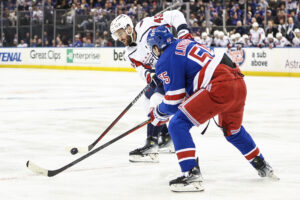We’d say the 2021-22 Vancouver Canucks collapse is like a house of cards, but that implies a structure. General manager Jim Benning hasn’t been playing with a full deck.
2021-22 Vancouver Canucks Collapse Complete
Here we go again. We’ve been through this before, but here’s the floor plan that created the Winchester Mystery House that is the 2021-22 Vancouver Canucks collapse. And it can be laid at the feet of the architect-who-wasn’t, Jim Benning.
Gotta Win Fast!
There is plenty out there about how Benning got the job, but it’s all speculation. No one in the room at the time will go on record, even if they do remember exactly what happened. Clearly, the idea of hiring the people who beat your team for the Stanley Cup has at least one good idea: they won. They must know what it takes to win. Hire them.
There are a few things that were obvious at the time. Owner Francisco Aquilini was only going to hire someone who told him that the team could win. After all, until the 2013-14 drop out of the playoffs under coach John Tortorella, the Canucks finished first in the division five years running. They couldn’t be that far off, could they? Aquilini had no appetite for a rebuild, he didn’t think the fans had an appetite for a rebuild, and so one wasn’t going to happen.
There was a nice PR shield in place with Trevor Linden installed as team president. He and Aquilini brought in Linden’s former teammate Jim Benning.
Working for the Goal
Don’t worry! For those of you fearing flashbacks, we’re not going to re-write his entire history here. Going to highlight the bits and move on in our excavations of the Canucks collapse. Links are there if you want more details.
Benning talked about wanting to make a “heavier” team in year one. There was work to do, but the most important – as far as the direction of the team went – thing was his trading away picks for borderline NHL players. In the push for a Stanley Cup, the previous general manager Mike Gillis had lost a lot of picks. The result was a very good team in a worse draft position – and no prospects. The deals Benning made in that first year – bringing in Linden Vey, Andrey Pedan, Sven Baertschi and others – were “filling the gaps” that those missing draft picks would have filled. Even his free-agent signings were good, getting Ryan Miller and Radim Vrbata! That’s so very, very long ago now…
A Pattern Emerges
The first year went great. The second not so much. But that pattern of moving out younger players or draft picks for players who were, in theory at least, more NHL ready remained. Emerson Etem, Philip Larsen, and Markus Granlund arrived for the exact same reasons the last bunch did. In theory, they were more “NHL ready” than the pieces moved out. But the real flashing lights came as bookends to the year.
The first was signing Brandon Sutter to a huge deal before he played a minute with the team. It was unlucky with his injuries, certainly. But it was also a small part of the team hamstringing itself with the salary cap. Not only was he overpaid, but it was a five-year deal for a player who hit 40 points once in six seasons.
Desperate Measures
Once the year was over, the call to bring in Erik Gudbranson for Jared McCann – and pay a premium to do so – was pure desperation. The Canucks collapse of 2015-16 clearly shook Benning. In case you forgot, the hype over the free-agent year of 2016 was MASSIVE. The biggest ever, or something like it. Out of that came another desperation move: the signing of Loui Eriksson. So, yeah. Year Three was one started in pure flop sweat.
It was also a miserable season. Benning, long criticized for keeping his free agents, likely bought himself time by finally trading away Jannik Hansen and Alexandre Burrows late in 2017-18. There was a brief, shining moment when it looked like the team was finally headed for the rebuild it so desperately needed. But it was also Daniel and Henrik Sedin‘s final season, soooo… Obviously, they signed a pile of free agents, including Sam Gagner for three years and $9 million. And a new coach, Travis Green.
No Rebuild For You!
The Sedins were gone, so there was nothing in the way of a complete, from-scratch teardown. Good frame was there in Brock Boeser and Bo Horvat. This hotshot kid named Elias Pettersson was coming in from Sweden. Jacob Markstrom was doing great. And there was some cap room now that could be judiciously used to – *record scratch* Fire Trevor Linden?
Obviously not much was said about it at the time, but it seems that there was a big divergence in strategy at the top. Linden was all for using this time to transition. Make sure the fans could see that the Canucks collapse over the past five seasons was leading to something. Change and, ideally, rebirth. Benning wanted to hire two old defensive centres for four years and $12 million and give them trade protection. Then another one for two years and $3.8 million.
Guess who won?
Vancouver, of course, had an atrocious year, and it was only blind luck and other teams’ desperation that let them draft Quinn Hughes. That luck held long enough for Benning to move Gudbranson for Tanner Pearson before the 2018-19 season was out. At almost the same time he moved Gagner and an unready Jonathan Dahlen. That was the good. The bad was the utter comedy of errors that was the goaltending fiasco in January. The team traded backup Anders Nilsson to the Ottawa Senators. When they tried to send the returning Mike McKenna to the AHL, he was plucked off waivers. Between injuries and absences, Michael DiPietro made his NHL debut and it didn’t go great.
Everything’s Gotta Go!
Benning did make a couple of good moves in 2019-20. Perhaps recognizing a weakness in others, he absolutely sniped J.T. Miller from the cap-strapped Tampa Bay Lightning. There is obviously plenty of room to debate trading off a first-round pick, but in a vacuum? It was a great deal. His hand was forced when Boeser went down to injury, but whatever the reason picking up Tyler Toffoli worked perfectly. He fit in seamlessly, scoring six goals and 10 points in his 10 regular-season games.
But again, bookend deals at either end of the year made a deeper impression. The season started with a bidding war for Tyler Myers, who the Canucks got for $6 million-a-year over five years. And it ended with no offer even being made to any of their veteran free agents – including Toffoli. It was a huge loss for the team and a big risk for Benning. Once again going on speculation, he chased a deal that would let him shed previous mistakes in return for taking on a high-risk contract.
Failing to get Oliver Ekman-Larsson did let the Canucks grab Nate Schmidt for a paltry cost. That the team then turned around and sent him to the Winnipeg Jets for that same cost the next season was purely a salvage move. Again, in a vacuum, that first move was a solid deal. And the second allowed Benning to make his biggest trade yet.
What Have You Done For Me Ever?
And that was a good trade. Bringing in Conor Garland and Ekman-Larsson while shedding salary is definitely a win. But it can’t be forgotten that the mistakes Benning corrected were his own. Those big, cumbersome deals moved out were the ones he signed. When Benning has moved decisively, it’s been because it was forced upon him. When his original plan to keep Vancouver in contention didn’t work, the rest was scrambling.
The signing of Loui Eriksson was Benning’s big, all-in move. That happened five seasons ago. The Vancouver Canucks collapse didn’t just continue… it accelerated. The long and short of it is that the Canucks have had one first-, two second-, and one third-round round pick in the last three drafts combined. For what should be a rebuilding team that’s having far too few of your best assets.
Not only did Benning not have an ace up his sleeve, he wasn’t playing with a full deck.
Main Photo:






